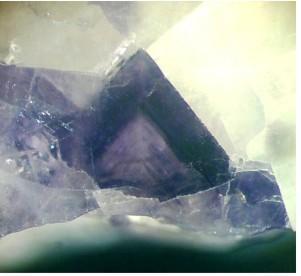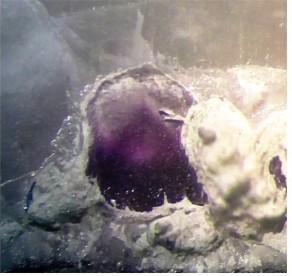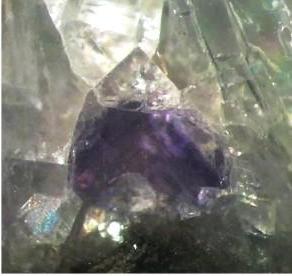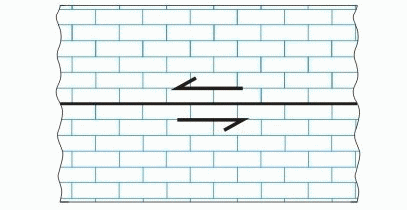Abstract
Сontent
- 1.Overview of work
- 1.1. The relevance of research
- 1.2. The aim of the work
- 1.3. Research methods
- 1.4. Scientific novelty
- 1.5. The practical significance
- 1.6. Personal contribution of the author
- 2. A review of research on the topic
- 3. The geological characteristic of mine
Nikanor-Nova
and fluorite mineralization - 4. Brief research results
- Conclusions
- References
1. Overview of work
1.1. The relevance of research
Donets Basin is primarily a source of coal, but within its territory are also available ore deposits and manifestations, including the gold-polymetalic and silver. This mineralization is often associated with of fluorite mineralization. The bulk of the fluorite is concentrated in the thicker areas of the carboxylic joint Donbass and Priazovsky crystal Massif, including explored intercession Kireevskoe deposit.
We have within the North Zone of small folding Donetsk coal Basin first established fluorite mineralization, detailed study which complements the information on regional mineralogy of Donbass.
In this regard, it is urgent that detailed data relating to the place of fluorite mineralization in the formation of these ore deposits and occurrences. It concerns the spread of fluorite mineralization genesis features, as well as factors controlling mineralization.
1.2. The aim of the work - identification of factors controlling mineralization fluorite of the field of mine "Nikanor-Nova".
Research tasks – carrying stratigraphic, lithofacies, tectonophysical, and thermobarogeochemical mineralogical studies to identify factors controlling fluorite mineralization.
Object of research – hydrothermal veins of carbonate rocks of the field of mine Nikanor-Nova
.
Subject of research – the factors that control of fluorite mineralization.
1.3. Research Methods
Methods of research aimed at identifying the factors above localization fluorite mineralization:
1. Geological and structural.
2. Tectonophysical.
3. Petrographic.
4. Lithofacies.
5. Mineral genetic.
6. Сrystals morphology.
7. Fazometric.
1.4. Scientific novelty
The first set fluorite mineralization with native silver in Selezevsk carboniferous area of Donetsk coal Basin. Studied the distribution of deformation structures enclosing mineralization. Obtained system barren and bearing fluorite mineralization with native silver formations, as well as set the sequence of their formation. Suggested search criteria fluorite mineralization.
1.5. Practical significance
The results complement the data available at the regional mineralogy of Donbass and can be used to predict of fluorite mineralization with native silver in the conjugate territories.
1.6. Personal contribution of the author
During the period 2006–2014 the author conducted mineralogical survey the whole area 51km2 research on the scale of 1:10,000, the central of the scale of 1:2000 and the southwestern part of the scale of 1:3000. During the shooting were found new mineralization fluorite, native silver, rock crystal, smoky quartz, iceland spar, Faden-quartz and sedimentary fluorite.
Based on the field, off-site and laboratory studies by the author highlighted the factors that control of fluorite mineralization systematically crack filling with different character, we studied the structural and textural features of living and mineral composition lived typomorphic features minerals, mineral-defined staging.
2. A review of research on the topic
During the analysis of literature and library materials on the genesis and factors controlling of fluorite deposits and occurrences of the world were identified tectonic, stratigraphic and lithologic-facies conditions and search features.
Tectonic control of fluorite mineralization is set for most fields of the Western Transbaikalia. For example, Torey and Bushin-Ulskaya group of fields located in areas of bending large fault represented by a series of step-tectonic fractures [1]. Lhameuren J. [2] highlights the pattern placement manifestations of fluorite mineralization in Mongolia with the structures of tectonic and magmatic activity. In the north of Donbass Volnuhinskoe manifestation of fluorite [3, 4] confined to the limestone F1 (С21 formation) oversees impairment (apophyses) thrusted Krasnodon.
Stratigraphic control. Khvorova V. I. [5] points to the findings of small inclusions of fluorite among limestones and dolomites of the Moscow syncline. Reshеtnyak N. D., Zatsiha B. V. [6, 7] indicates that the association of fluorite mineralization in the lower part of the zone Visean junction zone Donbass and Priazovsky crystal Massif.
Lithofacies control. Gusev A. I. [8] sets confinement of fluorite mineralization Yanterenskoe (Mountin Altai) to the packs of limestone with siliceous concretions. Panov B. S. [9] at the junction of Donbass and Priazovsky crystal Massif quarries Dokuchaevsk flux-dolomite plant installed confinement veins of calcite crystals of fluorite to the Visean limestones with siliceous concretions.
3. Geological characteristics of the rocks composing fluorite mineralization of the field of mine Nikanor-Nova
Calcite veins with fluorite mineralization are confined to a single stratigraphic horizon – limestone L7 (С26 formation). Fluorite mineralization is in the area of low-amplitude tectonics sublatitudinal. From the north and south of the site is limited thrust structures northeast strike. The occurrence of rocks inside the monoclinal with the fall in the north-west. In areas of thrust structures in crushed rock anticline.
4. Brief research results
During the field and office work was divided into three major structural and morphological types of calcite gangue fluorite mineralized bodies:
1) Veins associated with cracks interstratal bundle.
2) Cavity and druse associated with cracks interstratal bundle
3) Druses associated with cracks, split seams along the normal
Based on visual inspection of samples and a detailed microscopic description transparent and polished thin sections set pattern sequence of mineralization, clearly manifested on the zoning of fluorite crystals. In the veins associated with cracks interstratal bundles in the central part of the developed colorless crystals (CaFб), and on the periphery is dominated by purple (CaFф) and dark purple fluorite (fig. 2.a). In the cavity and druse associated with cracks interstratal bundle in the central part of the crystals developed a dark purple and purple (CaFф), gradually changes to pink, but on the periphery of the developed colorless fluorite (CaFб) (fig. 2.b). In the druses associated with cracks, split seams along the normal in the central part of the crystals developed light purple and purple (CaFф), and on the periphery prevails colorless fluorite (CaFб) (fig. 2.c).

| 
| 
|
| a | b | c |
Figure 2. The zoning of fluorite in different structural and morphological types of calcite vein bodies: а – veins; b – cavity and geodes; c – drusen
An exemplary sequence of mineral calcite gangue fluorite bodies shown in the following formulas:
veins:
[CacI+QcI+Py] (↑С°) – [CacII+Qдк+Qгх-QcII] (↑С°) – [CaмII+QмII] (↑С°) – [CaFб-CaFф-Ag] (↑С°)
cavity and geodes:
[CaмI+QмI] (↓С°) – [CaFф-CaFб] (↓С°) – [Qгх+Qдк-QcII+CacII-Ва-Ag] (↓С°) – [Саісл+Py] (↓С°)
drusen:
[CacI] (↓С°) – [CaFф-CaFб-Ag] (↓С°) – [Саісл+Ht] (↓С°)
where:
CacI – gray fine-grained calcite; CacII – coarse gray calcite; CaмI – fine-grained milky white calcite; CaмII – coarse milky white calcite; QcI – gray fine-grained quartz; QcII – coarse medium gray quartz; QмI – fine-grained milky white quartz; QмII – coarse milky white quartz; Qдк – smoky quartz; Qгх – rhinestone; CaFб – colorless fluorite; CaFф – purple and dark purple fluorite; Ва – barite; Саисл – Iceland spar; Py – pyrite; Ht – goethite; Ag – native silver.
Based on the sequence of mineralization it implies that the minerals in the veins formed against the background of a gradual increase in temperature, and blow geodes and friends – with a gradual decrease in temperature.
During tectonic studies found that the formation of calcite gangue fluorite bodies connected with local stresses occurring in the veins due to slippage in the folding layers (fig. 3). Blow geodes are confined to zones of bending rocks at folding. In areas of brittle deformation of the country rocks were formed drusen.

Figure 3 – Sequence of formation of veins
(animation: 5 frames, 5 cycles of repeating, 140 kilobytes)
Conclusions
As a result of field work, as well as microscopic examination of the veins and their host rocks has been allocated as follows:
- The basic structure of the expansion controlling of fluorite mineralization.
- Installed calcite vein bodies are confined to the limestone L7 C26 formation, where there are development siliceous nodules.
- Select the system cracks filled with fluorite vein mineralization.
- The structural-textural features and stages of mineral vein bodies with fluorite mineralization.
- Crystals studied typomorphic especially the veins.
- To determine the temperature change during the formation of the veins fazometrical studied by incorporation of the mineral crystals in the environment.
In writing this essay master's work is not yet complete. Final completion: December 2016. The full text of work and materials on the topic can be obtained from the author or his manager after that date.
References
- Гусельников В. И. Геологические предпосылки поисков флюоритовых месторождений в Забайкалье: Вопросы магматизма метаморфизма и рудообразования / В.И. Гусельников, А.А. Яжкин. – М.: Госгеолтехиздат, 1963. – С. 188–198.
- Лхамсурэн Ж. Флюоритовое оруденение Монголии (рудные формации, генезис и закономерности размещения). [текст]: автореф. дис. к-та г-м. наук: 04.00.14. / Новосибирск: Академия наук СССР, 1988. – 32 с.
- Завгородний А. Н. Новая находка флюорита в Донецком бассейне / А. Н. Завгородний, Л. И. Ильинский, А. Г. Лучинкин и др. / Геол. журн., 1972. – № 32. – С. 141–143.
- Фисуненко О. П. Памятники природы Луганской области и их изучение в краеведческих походах и экскурсиях / П. О. Фисуненко, Н. И. Удовиченко. – Луганский государственный педагогический институт им. Т. Г. Шевченко, 1993. – Ч. II. – 32 с.
- Хворова И. В. Атлас карбонатных пород среднего и верхнего карбона Русской пластформы / И. В. Хворова. – М.: Изд-во. АН СССР, 1958. – 154 с.
- Решетняк Н. Д. К вопросу о кремнистых образованиях нижнего карбона юго-западной окраины Донбасса / Н. Д. Решетняк. ДАН СССР. Т. 100, № 5, 1955. – С. 108.
- Зациха Б. В. Кристаллогенезис и типоморфные особенности минералов ртутного и флюоритового оруденений Украины / Б. В. Зациха. – М.: Наукова думка, 1989. – 192 с.
- Гусев А. И. Количественная и геолого-экономическая оценка прогнозных ресурсов плавикового шпата Алтайского края / А. И. Гусев. – Москва, 2002. – 25 с.
- Панов Б. С. Флюорит в Донецком бассейне / Б. С. Панов. – Харьков: Изд. Харьковского государственного университета, 1965.– 99 с.
